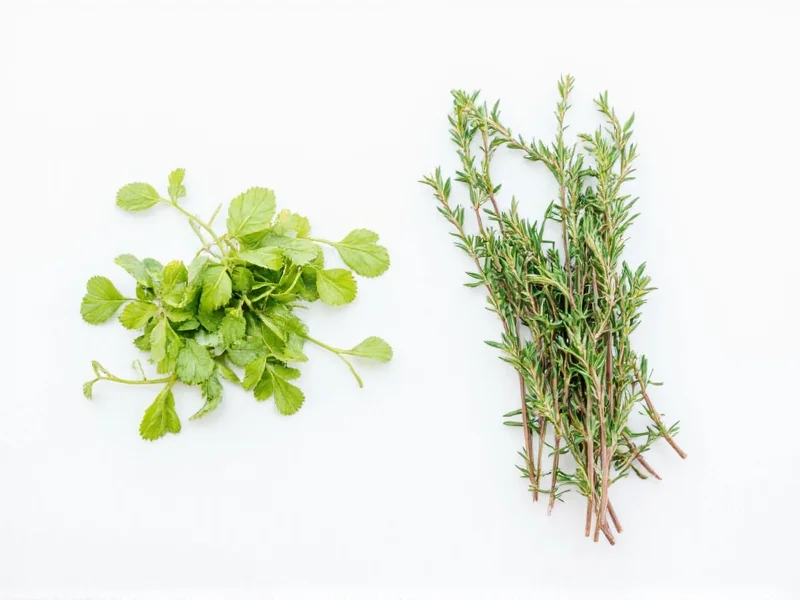When you're in the middle of cooking and realize you've run out of thyme, knowing reliable substitutions can save your recipe. Thyme's distinctive earthy, slightly floral flavor with hints of mint and lemon makes it a staple in many cuisines, particularly Mediterranean and French cooking. Understanding which herbs can effectively replace thyme depends on your specific recipe and what's available in your pantry.
Understanding Thyme's Unique Flavor Profile
Before selecting a substitute, it's essential to understand what makes thyme special. This perennial herb offers a complex flavor profile that's simultaneously earthy, slightly floral, and带有 subtle notes of mint and lemon. When dried, thyme becomes more concentrated and slightly more pungent. Recognizing these characteristics helps determine which substitute will work best for your particular dish.
Top Substitutes for Thyme in Cooking
Not all thyme alternatives work equally well in every recipe. The best substitution depends on whether you're making a delicate sauce, hearty stew, or roasted meats. Here's a detailed comparison of the most effective thyme replacements:
| Substitute | Flavor Comparison | Substitution Ratio | Best Used In |
|---|---|---|---|
| Oregano | More robust, slightly peppery | 3/4 tsp dried oregano = 1 tsp dried thyme | Pasta sauces, tomato-based dishes, pizza |
| Marjoram | Milder, sweeter cousin of oregano | 1:1 ratio (dried or fresh) | Egg dishes, light sauces, vegetable preparations |
| Rosemary | Stronger, pine-like flavor | 1/2 tsp dried rosemary = 1 tsp dried thyme | Roasted meats, potatoes, hearty stews |
| Savory | Peppery with thyme-like notes | 1:1 ratio (dried or fresh) | Bean dishes, stuffing, grilled vegetables |
| Herbes de Provence | Blend containing thyme plus other herbs | 1:1 ratio | French cuisine, roasted meats, vegetable dishes |
Understanding Fresh vs. Dried Thyme Substitutions
One common point of confusion involves substituting between fresh and dried thyme. Remember that dried herbs are more concentrated than fresh. The general rule is:
- 1 teaspoon dried thyme = 1 tablespoon fresh thyme
- When substituting other dried herbs for fresh thyme, use one-third the amount
- When substituting fresh herbs for dried thyme, triple the amount
For example, if a recipe calls for 1 teaspoon dried thyme and you only have fresh oregano, use 1 tablespoon fresh oregano. This conversion knowledge proves invaluable when adapting recipes based on what's available in your kitchen.
Best Substitutes by Dish Type
Certain thyme alternatives work better in specific culinary applications. Consider these recommendations when selecting your substitute:
For Meats and Poultry
Rosemary makes an excellent thyme substitute for roasted meats, particularly lamb and chicken. Its robust flavor stands up well to high-heat cooking. For more delicate meats like fish, marjoram provides a gentler alternative that won't overpower the dish. When creating herb crusts or rubs, a combination of oregano and a small amount of rosemary can effectively mimic thyme's complexity.
For Soups and Stews
Herbes de Provence works exceptionally well as a thyme replacement in soups and stews since it typically contains thyme along with complementary herbs like rosemary, marjoram, and lavender. If making a traditional French bouillon or consommé where thyme is essential, consider using a small amount of savory paired with a bay leaf for the most authentic flavor profile.
For Vegetable Dishes
When roasting or sautéing vegetables, marjoram serves as the closest substitute to thyme, offering similar earthy notes without overwhelming the natural flavors of the vegetables. For tomato-based vegetable dishes like ratatouille, oregano provides a more Mediterranean flavor profile that complements the acidity of tomatoes.
When Substitutions Fall Short
While these alternatives work well in most situations, certain recipes truly depend on thyme's unique flavor. Classic dishes like bouquet garni, herbes de Provence blends, and traditional French coq au vin rely specifically on thyme's distinctive taste. In these cases, consider making a quick trip to the store or growing your own thyme plant, which thrives in containers and provides fresh herbs year-round.
Creating Your Own Thyme Substitute Blend
For the most versatile thyme alternative, create a custom blend using what you have available:
- For dried thyme substitute: Mix equal parts dried marjoram and dried oregano with a pinch of dried rosemary
- For fresh thyme substitute: Combine fresh marjoram and fresh oregano in a 2:1 ratio
This blend captures thyme's complex flavor profile more accurately than any single herb substitute. Store dried blends in an airtight container for up to six months, while fresh blends should be used within two days for optimal flavor.
Practical Tips for Successful Substitutions
When substituting herbs in your cooking, keep these practical tips in mind:
- Add substitute herbs earlier in the cooking process for dried herbs, but later for fresh herbs
- Taste frequently and adjust seasoning as needed
- Consider the color impact—some substitutes like rosemary may alter the visual appearance of your dish
- When in doubt, start with less substitute and gradually increase to avoid overpowering your dish











 浙公网安备
33010002000092号
浙公网安备
33010002000092号 浙B2-20120091-4
浙B2-20120091-4